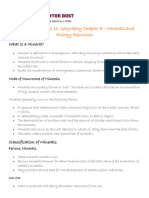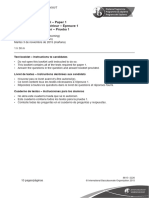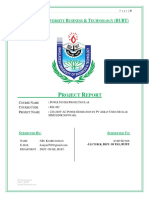Minerals and Energy Resources
Minerals
• Mineral as a “homogenous, naturally occurring substance with a definable internal structure.
• These are found in varied forms in nature, ranging from the hardest diamond to the softest talc.
Mode of Occurrence of Minerals
• Minerals are usually found in 'ores'.
→ The accumulation of any mineral mixed with other elements is called ore.
• Minerals generally occur in these forms:
→ In igneous and metamorphic rocks minerals may occur in the cracks, crevices, faults or joints.
The smaller occurrences are called veins and the larger are called lodes. Example: tin, copper,
zinc and lead etc.
→ In sedimentary rocks, a number of minerals occur in beds or layers. Example: Coal, iron,
gypsum, potash salt, sodium salt etc.
→ Minerals also found in the decomposition of surface rocks, and the removal of soluble
constituents, leaving a residual mass of weathered material containing ores. Example: Bauxite.
→ Minerals may occur as alluvial deposits in sands of valley floors and the base of hills
known as ‘placer deposits’. Example: Gold, silver, tin and platinum etc.
→ The ocean waters contain vast quantities of minerals. Example: Common salt, magnesium and
bromine etc.
Classification of Minerals• Minerals can be classified into three types:
→ Metallic Minerals
→ Non-Metallic Minerals
→ Energy Minerals
Metallic Minerals
• These minerals contain metals.
• These are of three types:
→ Ferrous minerals
♠ These minerals contain iron.
♠ It accounts for about three- fourths of the total value of the production of metallic minerals.
♠ They provide a strong base for the development of metallurgical industries.
Iron Ore
• It is the basic mineral and the backbone of industrial development.
• Magnetite is the finest iron ore with a very high content of iron up to 70 percent.
• Hematite ore is the most important industrial iron ore in terms of the quantity used, but has a
slightly lower iron content than magnetite. (50-60 percent).
• India is rich in good quality iron ores.
• The major iron ore belts in India are:
→ Odisha-Jharkhand belt
→ Durg-Bastar-Chandrapur belt in Chhattisgarh and Maharashtra
→ Bellary-Chitradurga-Chikmaglur-Tumkur belt in Karnataka
→ Maharashtra-Goa belt in Goa and Ratnagiri district of Maharashtra.
Manganese
• It is mainly used in the manufacturing of steel and ferro-manganese alloy.
• It is also used in manufacturing bleaching powder, insecticides and paints.
1 Prepared by: SHAAN SIR (B-Tech CSE, MBA(HR & IB) Trainer & Teacher at MAGNET
MINDS
�• Orissa is the largest producer of manganese ores in India.
→ Non-Ferrous Minerals
♠ These minerals do not contain iron.
♠ They play role in a number of metallurgical, engineering and electrical industries.
♠ Example of Non-ferrous minerals includes copper, bauxite, lead, zinc and gold.
Copper
• It is malleable, ductile and a good conductor, therefore, copper is mainly used in electrical
cables, electronics and chemical industries.
• The Balaghat mines in Madhya Pradesh, Khetri mines in Rajasthan and Singhbhum district of
Jharkhand are leading producers of copper.
Bauxite
• It is a clay-like substance from which alumina and later aluminium is obtained.
• Aluminium is an important metal because it combines the strength of metals such as iron, with
extreme lightness and also with good conductivity and great malleability.
• In India, mainly found in the Amarkantak plateau, Maikal hills and the plateau region of
Bilaspur-Katni.
Non-Metallic Minerals
• These minerals do not contain metal.
Mica
• It is a mineral made up of a series of plates or leaves.
• It can be clear, black, green, red yellow or brown.
• Mica is one of the most indispensable minerals used in electric and electronic industries due to
its excellent di-electric strength, low power loss factor, insulating properties and resistance to
high voltage,
• Leading producer are northern edge of the Chota Nagpur plateau. Koderma Gaya – Hazaribagh
belt of Jharkhand.
• Also produce in Ajmer, Rajasthan. Nellore mica belt of Andhra Pradesh.
Limestone
• Limestone is found in association with rocks composed of calcium carbonates or calcium and
magnesium carbonates.
• It is the basic raw material for the cement industry and essential for smelting iron ore in the
blast furnace.
Conservation of Minerals
Why to conserve minerals?
• Mineral deposits are present in very less quantity in the world i.e. one per cent of the earth’s
crust.
• The geological processes of mineral formation are so slow while the consumttion rate is very
fast therefore, mineral resources are finite and non-renewable.
• So, we have to conserve minerals so that it is available for future generation.
How to conserve minerals?
• A joint effort has to be made in order to use our mineral resources in a planned and sustainable
manner.
• Improved technologies need to be constantly evolved to allow use of low grade ores at low
costs.
• Recycling of metals, using scrap metals and other substitutes.
Energy Resources
2 Prepared by: SHAAN SIR (B-Tech CSE, MBA(HR & IB) Trainer & Teacher at MAGNET
MINDS
�• Energy is needed to cook, to provide light and heat, to propel vehicles and to drive machinery
in industries.
• It can be generated from fuel minerals like coal, petroleum, natural gas, uranium and from
electricity.
• Energy resources can be classified as
→ Conventional sources: include firewood, cattle dung cake, coal, petroleum, natural gas and
electricity
→ Non-conventional sources: include solar, wind, tidal, geothermal, biogas and atomic energy.
Conventional sources of Energy
• Coal
→ It is the most abundantly available fossil fuel.
→ It is used for power generation, to supply energy to industry as well as for domestic needs.
→ Coal is formed due the compression of plant material over millions of years.
→ There are various types of coals (on the degrees of compression and the depth and time of
burial):
♠ Peat: Low carbon and high moisture contents and low heating capacity.
♠ Lignite: Low grade brown coal, which is soft with high moisture content.
♠ Bituminous: Buried deep and subjected to increased temperatures. Most popular coal in
commercial
use.
♠ Anthracite: Highest quality hard coal.
→ In India, coal occurs in Gondwana and tertiary rock stages.
→ The major resources of Gondwana coal are located in
♠ Damodar valley (West Bengal-Jharkhand).
♠ Jharia, Raniganj, Bokaro
♠ The Godavari, Mahanadi, Son and Wardha valleys.
→ Tertiary coals occur in the north eastern states of Meghalaya, Assam, Arunachal Pradesh and
Nagaland.
• Petroleum
→ It provides fuel for heat and lighting, lubricants for machinery and raw materials for
manufacturing industries.
→ Petroleum refineries act as a “nodal industry” for synthetic textile, fertiliser and numerous
chemical industries.
→ About 63 per cent of India’s petroleum production is from Mumbai High, 18 per cent from
Gujarat and 16 per cent from Assam.
• Natural Gas
→ It is used as a source of energy as well as an industrial raw material in the petrochemical
industry.
→ It is considered an environment friendly fuel because of low carbon dioxide emissions.
→ Natural gas have been discovered in the Krishna- Godavari basin, Mumbai High and allied
fields, Gulf of Cambay. Andaman and Nicobar islands.
• Electricity
→ It has a wide range of applications in today’s world.
→ Electricity is generated mainly in two ways:
♠ by running water which drives hydro turbines to generate hydro electricity
♠ by burning other fuels such as coal, petroleum and natural gas to drive turbines to produce
3 Prepared by: SHAAN SIR (B-Tech CSE, MBA(HR & IB) Trainer & Teacher at MAGNET
MINDS
�thermal power.
→ Hydro electricity is generated by fast flowing water
♠ It is a renewable resource.
♠ Multi-purpose projects like the Bhakra Nangal, Damodar Valley corporation, the Kopili Hydel
Project etc. produce hydro electricity.
→ Thermal electricity is generated by using coal, petroleum and natural gas.
♠ The thermal power stations use non-renewable fossil fuels for generating electricity.
Non-Conventional Sources of Energy
• Nuclear or Atomic Energy
→ It is obtained by altering the structure of atoms.
→ It is used to generate electric power.
→ Uranium and Thorium are available in Jharkhand and the Aravalli ranges of Rajasthan.
→ The Monazite sands of Kerala is also rich in Thorium.
• Solar Energy
→ India is a tropical country, therefore it has enormous possibilities of tapping solar energy.
→ Photovoltaic technology converts sunlight directly into electricity.
→ Solar energy is fast becoming popular in rural and remote areas which help in minimising the
dependence of rural households on firewood and dung cakes that will contribute to
environmental conservation and adequate supply of manure in agriculture.
• Wind Power
→ India has great potential of wind power.
→ Largest wind farm cluster is located in Tamil Nadu from Nagarcoil to Madurai.
→ Andhra Pradesh, Karnataka, Gujarat, Kerala, Maharashtra and Lakshadweep have important
wind farms.
→ Nagarcoil and Jaisalmer are well known for effective use of wind energy in the country.
• Biogas
→ Shrubs, farm waste, animal and human waste are used to produce biogas for domestic
consumption in rural areas.
→ Biogas plants using cattle dung are known as ‘Gobar gas plants’ in rural India.
→ Biogas provide twin benefits to the farmer in the form of energy and improved quality of
manure.
• Tidal Energy
→ Oceanic tides can be used to generate electricity.
→ In India the Gulf of Khambhat, the Gulf of Kuchchh in Gujarat on the western coast and
Gangetic delta in Sunderban regions of West Bengal provide ideal conditions for utilising tidal
energy.
• Geo Thermal Energy
→ The heat and electricity produced by using the heat from the interior of the Earth is called Geo
thermal Energy.
→ Groundwater in high tempratures area absorbs heat from the rocks and becomes hot.
♠ It is so hot that when it rises to the earth’s surface, it turns into steam.
♠ This steam is used to drive turbines and generate electricity.
→ Two experimental projects have been set up in India to utilize geothermal energy:
♠ Parvati valley near Manikarn in Himachal Pradesh
♠ Puga Valley, Ladakh.
Conservation of Resorces
4 Prepared by: SHAAN SIR (B-Tech CSE, MBA(HR & IB) Trainer & Teacher at MAGNET
MINDS
�• Energy is a basic requirement for economic development.
• There is an urgent need to develop a sustainable path of energy development.
• There are two ways for adopting the path of sustainable development of energy:
→ Promotion of energy conservation
→ increased use of renewable energy sources
• Some steps in this direction are:
→ Using public transport systems instead of individual vehicles
→ Switching off electricity when not in use
→ Using power-saving devices
→ Using non-conventional sources of energy.
NCERT EXERCISE QUESTIONS
1. Multiple choice questions.
(i) Which one of the following minerals are formed by the decomposition of rocks, leaving a
residual mass of weathered material?
(a) Coal (b) Bauxite (c ) Gold (d) Zinc
Answer: (b) Bauxite
(ii) Koderma, in Jharkhand, is the leading producer of which one of the following
minerals?
(a) Bauxite (b) Mica (c) Iron Ore (d) Copper
Answer: (b) Mica
(iii) Minerals are deposited and accumulated in the strata of which of the following rocks?
(a) Sedimentary Rocks (b) Metamorphic Rocks (c ) Igneous Rocks (d) None of the above
Answer: (a) Sedimentary Rocks
(iv) Which one of the following minerals is contained in the Monazite sand?
(a) Oil (b) Uranium (c) Thorium (d) Coal
Answer: (c) Thorium
2. Answer the following questions in about 30 words.
(i) Distinguish between the following in not more than 30 words.
a. Ferrous and non-ferrous minerals
5 Prepared by: SHAAN SIR (B-Tech CSE, MBA(HR & IB) Trainer & Teacher at MAGNET
MINDS
�b. Conventional and non-conventional sources of energy
Answer:
a. Difference between ferrous and non-ferrous minerals:
Ferrous minerals Non-ferrous minerals
Metallic minerals which contain iron are
Metallic minerals which do not contain iron are
called ferrous minerals.
called non-ferrous minerals.
For example - iron ore, manganese, nickel,
For example - copper, bauxite, tin, etc.
cobalt, etc.
b. Difference between conventional and non-conventional sources of energy:
Conventional sources of energy Non-conventional sources of energy
The sources of energy which have been invented in
The sources of energy which are being
recent times and are more efficient and comfortable
used since the early times are considered
are considered as the non-conventional sources of
as the conventional sources of energy.
energy.
For example - firewood, cattle dung cake,
For example - solar, wind, tidal, geothermal, biogas,
coal, petroleum, natural gas, etc.
nuclear energy, etc.
(ii) What is a mineral?
Answer: A mineral can be defined as a homogenous, naturally occurring substance with a
definable internal structure. Minerals are found in varied forms in nature, ranging from the
hardest diamond to the softest talc.
(iii) How are minerals formed in igneous and metamorphic rocks?
Answer: In igneous and metamorphic rocks, minerals may occur in the cracks, crevices, faults or
joints. The smaller deposits are called veins and the larger ones are called lodes. When the
minerals in liquid/ molten and gaseous forms are forced upward through cavities towards the
earth’s surface, they cool down and solidify to form veins or lodes. Metallic minerals like tin,
copper, zinc and lead are obtained from veins and lodes.
(iv) Why do we need to conserve mineral resources?
Answer: We need to conserve mineral resources as they are limited on the earth. It takes billions
of years for them to be replenished in nature. Continued extraction of ores leads to increasing
costs of extraction and a decrease in quality as well as quantity. It takes millions of years for the
formation of minerals. Thus, as compared to the current rate of consumption, the rate of
replenishment of minerals is very slow.
6 Prepared by: SHAAN SIR (B-Tech CSE, MBA(HR & IB) Trainer & Teacher at MAGNET
MINDS
�3. Answer the following questions in about 120 words.
(i) Describe the distribution of coal in India
Answer:
In India, major coal deposits are found on the eastern side of the country. Some of the main sites
of coal are described below:
In India, coal occurs in rock series of two main geological ages Gondwana (200 million
years old) and tertiary (55 million years old).
The major resources of Gondwana or metallurgical coal are located in the Damodar
valley (West Bengal, Jharkhand), Jharia, Raniganj and Bokaro.
The Godavari, Mahandi, Son and Wardha valleys also contain coal deposits.
Tertiary coals occur in the north-eastern states of Meghalaya, Assam, Arunachal Pradesh
and Nagaland.
(ii) Why do you think that solar energy has a bright future in India?
Answer:
Solar energy is a renewable source of energy produced from the sunlight. It has a bright future in
India due to the following reasons:
India is a tropical country due to which it receives abundance of sunlight throughout the
year.
Solar plants can be easily established in rural and remote areas of the country.
It will reduce the dependence of rural households on firewood and dung cakes which will
ultimately reduce the pollutions and help to conserve the environment.
7 Prepared by: SHAAN SIR (B-Tech CSE, MBA(HR & IB) Trainer & Teacher at MAGNET
MINDS






















































































